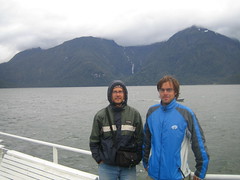Return to the Jungle
After spending the last month and a half in an area that looks more or less like parts of North America, we´re back in unfamiliar territory. Right now we´re in Salta in NW Argentina, just waiting to catch a bus to Bolivia. It´s a nice city, the second oldest of Argentina, with a lot of colonial buildings still remaining. That´s one thing southern Argentina didn´t have. Also, there are many more native Americans here compared to the almost 100% European population of Buenos Aires and the south. There´s supposed to be a big street party here tonight. We´re catching the bus at midnight so we´ll see how much of it we can take in. By the way, we´re not in the jungle right now. We were there earlier in the week.
I´ll stop boring you and talk about the main event of the week: Iguazu Falls. Actually, there´s not much to say, you´ll just have to look at the pictures. We arrived there on Tuesday morning after another night bus. This time however, we went in Salon Cama instead of semi-cama; it was only $5 more. We have been wanting to try this. The main difference is that there are only three seats across instead of four, so they´re wider (to state the obvious). They´re supposed to have more legroom too, but there was a board blocking our feet from going under the seat in front so really there wasn´t more legroom. The service was decent, but we´ve had better, so all in all we prefer semi-cama. Like I said, we arrived in Puerto Iguazu Tuesday morning. We spent the day relaxing by the pool, and had steak (again) for supper. This time we cooked it ourselves. Puerto Iguazu, 20 minutes from the falls, is located in the narrow province of Missiones in Northeast Argentina, which is hugged by the Rio Parana and Rio Uruguay, across which are Paraguay and Brazil. You can actually see all three countries at the same time from one part of the city. I´m sorry, I´m still boring you. To the falls now.
We hadn´t heard about Iguazu Falls until we started planning this trip. The more we heard people talk, the more we realized we had to go there. And we weren´t dissapointed. They are located on the border with Brazil, from where they can also be seen. I don´t have any information on volume of water or anything, but I can´t imagine any falls being bigger. Upon seeing them, Eleanor Roosevelt said : ¨Poor Niagara.¨ It´s a series of 20 to 50 (I have no idea) individual falls which look like one continuous waterfall from a distance. All we could do was stare for hours. We walked all the circuits so we got several different viewpoints. At one point we were only about 50 yards from Brazil. That was pretty cool. At the end of the day we were right above the biggest falls under which is a perpetual cloud of spray. We got soaked a couple times.
We got this Uruguayan guy to take a couple pictures of us, mostly cause he had two hot daughters. Anyway, after they left, his wife came back and asked us if we knew Ryan Barton from Canada. It´s funnier when it really happens, than when you hear about it. We tried to contain ourselves, realizing the opportunity that was in front of us. No, we didn´t say: ¨Yes we know Ryan Barton.¨ We did however, manage to get the girls to sit down with us at the patio for something to drink. Then they left.
Thursday morning we left for San Ignacio Mini, to visit the Jesuit ruins, another UNESCO World Heritage Site. It was fairly impressive considering the story behind it. There was a large plaza surrounded by ruins of a church and several dwellings. The Jesuit Order came to this area in the early 1600s and founded several missions. They preached Christianity to the Guarani Indians and created these community housing projects where each family had a dwelling, and everybody shared the land, and shared the work. These communes became so powerful, about 30 towns with a total population of 140, 000, that the Spanish eventually had them expelled. The history behind the whole thing is amazing to me. Our whole trip has been somewhat of a history lesson. Here´s what I learned this week. The Spaniards used Christianity as a reason to invade South America. They imposed their European way of life onto the Indians, forcing them to work the fields and mines for coffee and silver which the Spaniards sent back home to reap all the profits from. In return, the Indians were given the right to be taught Christianity. The Jesuits, on the other hand, believed so strongly in the gospel that they risked their lives by coming into the jungle. They did all their teaching in the Guarani language, and taught them farming and domestic skill, all for the benefit of the Guarani themselves. The Jesuits gained nothing. Throughout the centuries they were repeatedly attacked by the Paraguayans and Portuguese, until their eventual expulsion by the Spanish in the early 1800s. I think they understood the meaning of faith.
At this time tomorrow we will be in Bolivia, if all goes well.
Happy Easter,
Pieter


1 Comments:
We were listening to CBC replay its story about the baroque music of Bolivia and it is a wonderful story.
It's a long time since I watched "The Mission" which is about Christianity being taken to the indiginous peoples and it may well support your take on their history.
We are never bored by your blog, in fact you may just have to continue travelling forever to continue with the journal.
Nora
Post a Comment
<< Home